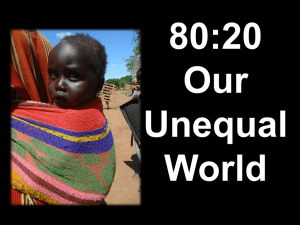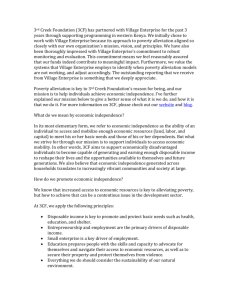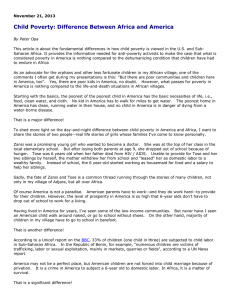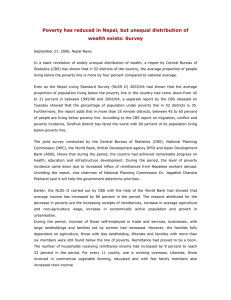80:20 Our Unequal World
advertisement
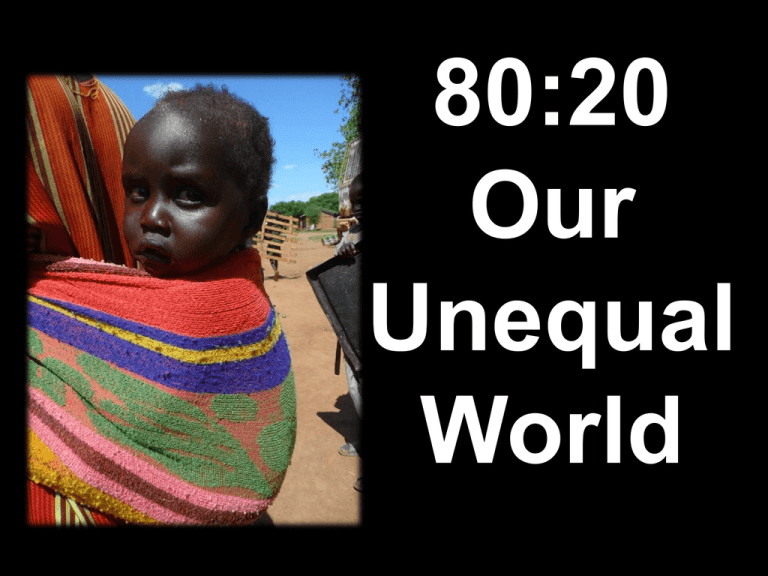
80:20 Our Unequal World Our Unequal World Today, approximately 80% of the world’s population live in the ‘Third World’ or ‘Developing World’, and for that reason, it is sometimes referred to as the ‘Majority World’. This huge majority population has access to an unequal share of the world’s resources and human welfare. How Many People? The world has 100 people. How many people would be from: – Asia? – African? – Europe? – South America? – North America? – Oceania? The World Village If the world’s population shrunk to a village of 100 people, there would be: • • • • 61 Asians 14 Africans 12 Europeans 7 people from Latin America and the Caribbean • 5 North Americans • 1 from Oceania • • • • • • • 47 would live in a city 30 would be under 15 7 would be over 65 20 would be living in absolute poverty 20 would not have access to safe water 14 adults would be unable to read 8 would not be expected to live to the age of 40 The ‘Developing World’ has: • • • • • • • • 80% of the world’s people 15% of the world’s education spending 7% of the world’s health expenditure 18% of the world’s GNP 65% of the world’s refugees 38% of the world’s carbon emissions 95% of the world’s wars 95% of people living with HIV/AIDS The ‘Developing World’ has: • 25% of the world’s industrial production • 26% of the world’s electricity consumption • 61% of the world’s cereal production • 36% of world export earnings • 7 of the 10 largest cities in the world • In 1999, developing countries received official aid worth 0.6% of their GDP ($7 per person), but paid 5.2% in debt service ($22 per person). Consider ... • Each year 40 million people die from hunger-related diseases— the equivalent of 300 airplane crashes a day. • 10 million children a year die before the age of five, most from preventable diseases. • 1.1 billion people live on less than $1 per day and 2.7 billion live on less than $2 per day. • 12% of the world’s population uses approximately 85% of its water, and this 12% does not live in the Third World. At least 80% of humanity lives on less than $10 a day. According to UNICEF, 22,000 children die each day due to poverty. And they “die quietly in some of the poorest villages on earth, far removed from the scrutiny and the conscience of the world. Being meek and weak in life makes these dying multitudes even more invisible in death.” Around 27-28 percent of all children in developing countries are estimated to be underweight or stunted. The two regions that account for the bulk of the deficit are South Asia and subSaharan Africa. Less than one per cent of what the world spent every year on weapons was needed to put every child into school by the year 2000 and yet it didn’t happen. Nearly a billion people entered the 21st century unable to read a book or sign their names. 1.6 billion people — a quarter of humanity — live without electricity Approximately half the world’s population now live in cities and towns. In 2005, one out of three urban dwellers (approximately 1 billion people) was living in slum conditions Wealth and poverty today • In 1960, the richest 20% of the world’s people shared between them 70% of the entire wealth of the planet. • By the mid1990’s, this figure increased to over 85%. In 2013 the world’s 85 richest people owned assets with the same value as those owned by the poorer half of the world’s population, or 3.5 billion people. The majority of the world’s people remain poor. The largest concentrations of poverty and underdevelopment in the world occur throughout sub-Saharan Africa, South Asia and Latin America. In countries like Niger or Sierra Leone, not being poor is the exception, rather than the rule. 80:20 Dare to Dream a Different World
